TABLE OF CONTENTS
|
January 2017 Volume 13, Issue 1 |
 |  |  |
 |  Research Highlights Research Highlights
 News and Views News and Views
 Brief Communications Brief Communications
 Articles Articles
| |
 |
|
 |
 |
Research Highlights |  Top Top |
 |
 |
 |
RNA structure: Widening the probe | Biocatalysis: Custom carbon cycling | Neurodegeneration: Untangling tau | Protein folding: Minimizing frustration
|
News and Views |  Top Top |
 |
 |
 |
| |
 |
Brief Communications |  Top Top |
 |
 |
 |
|
 |
 |
 |
|
 |
 |
 |
A multi-step peptidolytic cascade for amino acid recovery in chloroplasts pp15 - 17
Pedro F Teixeira, Beata Kmiec, Rui M M Branca, Monika W Murcha, Anna Byzia et al.
doi:10.1038/nchembio.2227

Mass spectrometry analysis of stromal extracts reveal a peptidolytic cascade in the plant chloroplast consisting of oligopeptidases and aminopeptidases that mediates the complete degradation of signal peptides to free amino acids.
|
|
|
 |
 |
 |
|
 |
Articles |  Top Top |
 |
 |
 |
Structure of p300 in complex with acyl-CoA variants pp21 - 29
Zuzanna Kaczmarska, Esther Ortega, Afsaneh Goudarzi, He Huang, Sunjoo Kim et al.
doi:10.1038/nchembio.2217

Structural and biochemical studies of the histone acetyltransferase p300 in complex with acyl-CoA substrates reveal a lysine binding channel that accommodates a particular chain length to mediate efficient histone modification.
|
|
|
 |
 |
 |
|
 |
 |
 |
Profiling drugs for rheumatoid arthritis that inhibit synovial fibroblast activation pp38 - 45
Douglas S Jones, Anne P Jenney, Jennifer L Swantek, John M Burke, Douglas A Lauffenburger et al.
doi:10.1038/nchembio.2211
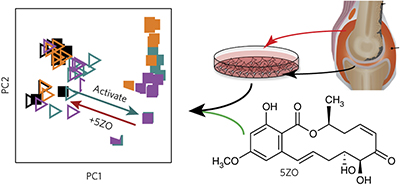
A systems-level look at the activation of joint synovial fibroblasts in rheumatoid arthritis patients in response to different activators and therapeutic kinase inhibitors shows that multivariate inhibitor effects depend on the nature of the activator, not on the disease state per se.
|
|
|
 |
 |
 |
|
 |
 |
 |
|
 |
 |
 |
|
 |
 |
 |
|
 |
 |
 |
Tunable thermal bioswitches for in vivo control of microbial therapeutics pp75 - 80
Dan I Piraner, Mohamad H Abedi, Brittany A Moser, Audrey Lee-Gosselin and Mikhail G Shapiro
doi:10.1038/nchembio.2233
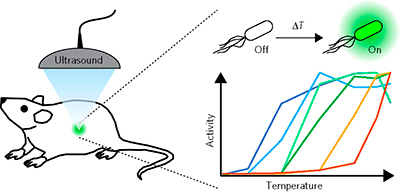
Engineering of temperature-sensitive DNA repressors led to thermal bioswitches, allowing Escherichia coli to respond sharply to temperature at tunable set points and enabling application to host diagnostics and disease therapy.
|
|
|
 |
 |
 |
|
 |
 |
 |
|
 |
 |
 |
The RNA helicase Mtr4p is a duplex-sensing translocase pp99 - 104
Eric M Patrick, Sukanya Srinivasan, Eckhard Jankowsky and Matthew J Comstock
doi:10.1038/nchembio.2234
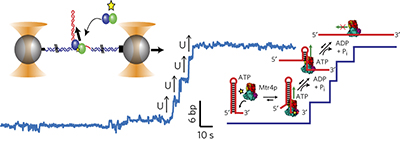
Single-molecule high-resolution optical trapping techniques elucidate the molecular mechanisms underlying the unwinding of RNA duplexes by the helicase Mtr4p, including how it restricts directional translocation to duplex regions.
|
|
|
 |
 |
 |
Ubiquitin utilizes an acidic surface patch to alter chromatin structure pp105 - 110
Galia T Debelouchina, Karola Gerecht and Tom W Muir
doi:10.1038/nchembio.2235
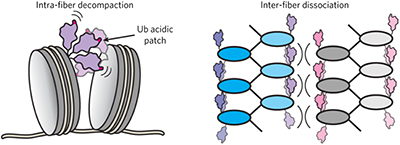
Hydrogen-deuterium (H/D) exchange combined with NMR spectroscopy analysis of nucleosomal arrays identified an acidic patch on ubiquitin that mediates chromatin decompaction and further supports that ubiquitin-ubiquitin interactions are needed for chromatin solubilization.
|
|
|
 |
 |
 |
|
 |
 |
 |
A computationally engineered RAS rheostat reveals RAS-ERK signaling dynamics pp119 - 126
John C Rose, Po-Ssu Huang, Nathan D Camp, Jordan Ye, Andrew M Leidal et al.
doi:10.1038/nchembio.2244
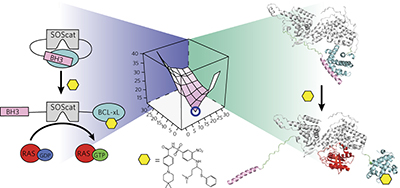
Computational design enables the generation of a chimeric construct of the RAS exchange factor SOS that is specifically activated by a small molecule. The expression of this construct in different cell types reveals distinct phosphorylation kinetics.
|
|
|
 |
 Top Top |
 |
 |
 |  |  |  |  |  | Natureevents is a fully searchable, multi-disciplinary database designed to maximise exposure for events organisers. The contents of the Natureevents Directory are now live. The digital version is available here.
Find the latest scientific conferences, courses, meetings and symposia on natureevents.com. For event advertising opportunities across the Nature Publishing Group portfolio please contact natureevents@nature.com |  |  |  |  |  |
|
 |


No comments:
Post a Comment